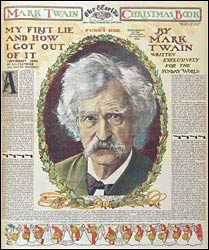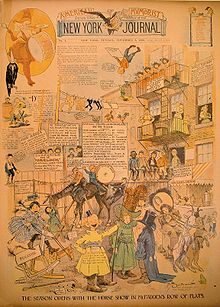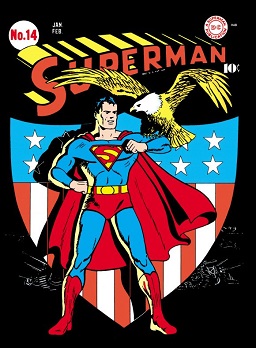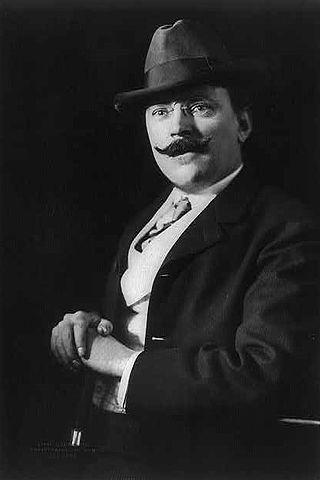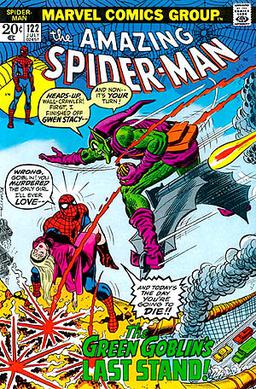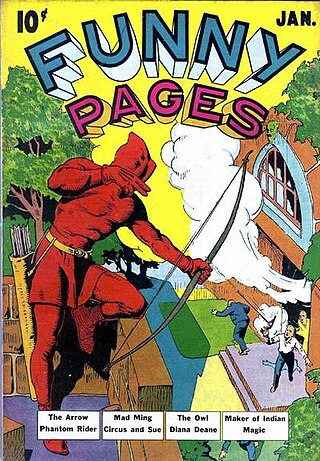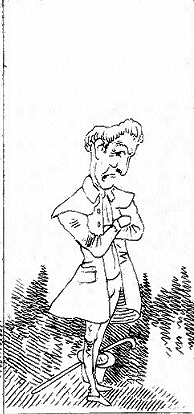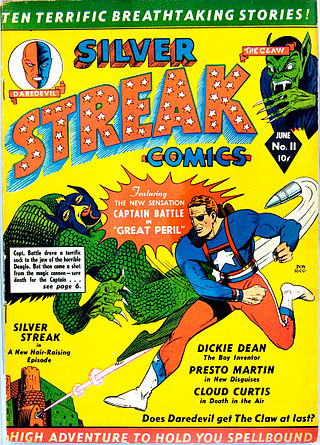Overview

The history of American comics started in 1842 with the U.S. publication of Rodolphe Töpffer's work The Adventures of Mr. Obadiah Oldbuck, [3] [4] but the medium was initially developed through comic strips in daily newspapers. The seminal years of comic strips established its canonical features (e.g., speech balloons) and initial genres (family strips, adventure tales). Comic-strip characters became national celebrities, and were subject to cross-media adaptation, while newspapers competed for the most popular artists.
The first American-style true comic book, published independently of a newspaper ( Famous Funnies: A Carnival of Comics ), appeared in 1933. [5] Although the first comic books were themselves newspaper-strip reprints, comics soon featured original material, and the first appearance of Superman in 1938 launched the Golden Age of Comic Books. During World War II, superheroes and talking animals were the most popular genres, but new genres were also developed (i.e., western, romance, and science fiction) and increased readership. Comic book sales began to decline in the early 1950s, and comics were socially condemned for their alleged harmful effects on children; to protect the reputation of comic books, the Comics Code Authority (CCA) was formed, but this eliminated the publication of crime and horror genres.
The Silver Age of Comic Books began in 1956 with a resurgence of interest in superheroes. Non-superhero sales declined and many publishers closed. Marvel Comics introduced new and popular superheroes and thereby became the leading comics publisher in the Bronze Age of Comic Books (from 1970 to 1985). Unlike the Golden and Silver ages, the start of the Bronze Age is not marked by a single event. Although the Bronze Age was dominated by the superhero genres, underground comics appeared for the first time, which addressed new aesthetic themes and followed a new distribution model.
Following the Bronze Age, the Modern Age initially seemed to be a new golden age. Writers and artists redefined classic characters and launched new series that brought readership to levels not seen in decades, and landmark publications such as Maus redefined the medium's potential. The industry, however, soon experienced a series of financial shocks and crises that threatened its viability, and from which it took years to recover.
Periodization schemes
American comics historians generally divide 20th-century American comics history chronologically into ages. The first period, called Golden Age, extends from c. 1938 (first appearance of Superman in Action Comics #1 by National Allied Publications, a corporate predecessor of DC Comics) to 1956 (introduction of DC's second incarnation of The Flash). The following period, the Silver Age, goes from 1956 to 1970. The Bronze Age follows and spans from 1970 to 1985. Finally the last period, from c. 1985 until today, is the Modern Age. [6] This division is standard but not all the critics apply it, since some of them propose their own periods, [6] [7] and the dates selected may vary depending on the authors.
The first recorded use of the term "Golden Age" pertaining to comics was by Richard A. Lupoff in an article, "Re-Birth", published in issue one of the fanzine Comic Art in April 1960. [8] The first use of the terms "Golden Age" and "Silver Age" together as comic periodization was in a letter from a reader published in Justice League of America #42 (February 1966) that stated: "If you guys keep bringing back the heroes from the Golden Age, people 20 years from now will be calling this decade the Silver Sixties!" [9] [10] Comics historian/movie producer Michael Uslan says this natural hierarchy of gold–silver–bronze, akin to Olympic medals, soon took hold in common parlance: "Fans immediately glommed onto this, refining it more directly into a Silver Age version of the Golden Age. Very soon, it was in our vernacular, replacing such expressions as ... 'Second Heroic Age of Comics' or 'The Modern Age' of comics. It wasn't long before dealers were ... specifying it was a Golden Age comic for sale or a Silver Age comic for sale." [10]
Alternative schemes
In A Complete History of American Comic Books, Shirrel Rhoades cites Steve Geppi (the publisher of the Overstreet Comic Book Price Guide ) who, taking into account comic strips, divides the history of comics in ages: [11] Victorian (Victorian Age, from 1828 to 1882), of platinum (Platinum Age, from 1882 to 1938), of gold (Golden Age, from 1938 to 1945), atomic (Atom Age, from 1946 to 1956), of silver (Silver Age, from 1956 to 1971), of bronze (Bronze Age, from 1971 to 1985), of copper (Copper Age, from 1986 to 1992), of chrome (Chrome Age, from 1992 to 1999), and modern (Modern Age, 2000 to present). According to Rhoades, consideration of comic strips in the general history of comics has led Geppi to add two periods before the Golden Age: the Victorian Age (from 1828 to 1882) and the Platinum Age (the period of comic strips). [11]
Alternative definitions of these periods exist, as comics historian William W. Savage sets the ending of the Atom Age (the period in which there was a prevalence of atomic-bomb narratives and horror stories) in 1954, the year that the Comics Code Authority prohibited most of what had appeared prior to 1954. [12] The website Copper Age Comics proposes that the Copper Age began in 1984 with Marvel's Secret Wars limited series and ended in 1991 with Jim Lee's X-Men series. In 1992, a group of Marvel artists (including Jim Lee) defected to form the creator-owned Image Comics; the site marks this as the beginning of the Modern Age, which continues to the present. [13]
An alternative name for the period after the mid-1980s is the Dark Age of Comic Books. [14] Pop culture writer Matthew J. Theriault proposed the Dark Age (c. 1985 to 2004), the Modern Age (beginning c. 2004 with the publication of Marvel's "Avengers Disassembled" and DC Comics' "Infinite Crisis", and ending c. 2011), and the Postmodern Age (beginning c. 2011 with the publication of Ultimate Fallout #4, the first appearance of Miles Morales, and continuing to the present). [15] Comics creator Tom Pinchuk proposed the name Diamond Age (2000–present) for the period starting with the appearance of Marvel's Ultimate line. [16]
Graphical timeline


